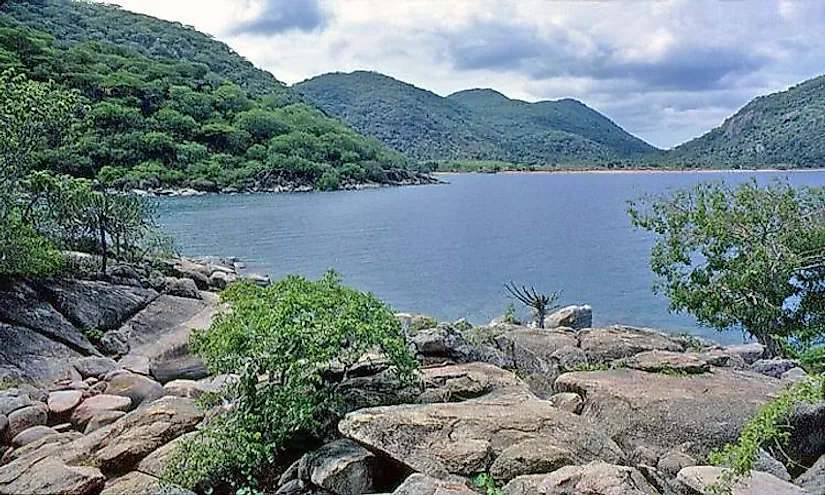Ecological Regions Of Malawi

Malawi is a tropical, landlocked, South African nation filled with hilly terrains and freshwater ecosystems. The state shares land borders with Mozambique, Zambia, and Tanzania. The country’s highest point is Mount Mulanje, at an elevation of 9,849 feet in Chiradzulu District. The lowest point lies at the intersection of the Shire River and the international boundary with Mozambique (37 meters).
Ecological Regions Of Malawi
Central Zambezian Miombo Woodlands
This ecoregion is classified under the tropical and subtropical grasslands, savannas, and shrublands biome. The ecoregion covers large portions of western and northern Malawi. Annual precipitation ranges from 550-1700 mm between November and March while temperatures are recorded at a minimum of 9 to a maximum of 30 degrees Celsius.
Miombo trees reach a height of between 15-20 meters and support an undergrowth of shrubs and grassland. Approximately 8,500 plant species have been recorded in the area, with nearly half of them being endemic. Notable fauna includes black rhinos, antelopes, lion, hyena, eland, elephant, monkey, baboons, leopards, and buffalo. The wildlife is however threatened by poaching. Other threats to the ecoregion are urban development, fires, and deforestation. The Kasungu and Nyika National Parks were established for conservation purposes in the region.
Lake Malawi
Lake Malawi is a great lakes freshwater ecoregion in Malawi. The region encompasses Lake Malawi (Lake Nyasa) along with its influents, Shire River and Lake Malombe. Lake Malawi represents the southernmost of Rift Valley’s lakes. The ecoregion’s geography is characterized by islets, islands, and reefs. The lake’s coastline varies from steep and rocky, to plains and sandy bays. Annual precipitation ranges from 600 to 2,200 mm.
The lake is especially rich in cichlids alongside populations of lake sardine, African tetra, spotted killifish, catfish species, crustaceans, and mollusks. The painted hunting dog, monkeys, hippopotamus, and Nile crocodile are some of the larger animals sustained by the lake. This ecoregion is continuously threatened by excessive fishing and oil exploration activities.
Southern-Rift Montane Forest-Grassland Mosaic
This ecoregion is classified in the montane grasslands and shrublands biome. The ecoregion lies in the northern and eastern shores of Lake Malawi and encompasses a network of mountains and plateaus. Annual mean precipitation is estimated at 1,500 mm from November to April. The region’s geology consists of sedimentary rocks, ash, lavas, schists, and granites.
The vegetation is composed of grasslands along with orchids, geraniums, sedges and herbs. Pockets of Afro-montane forests support an undergrowth of shrubs and epiphytes. Notable fauna includes lion, zebra, reedbuck, elephants, hyena, and leopard. The Nyika National Park was established to protect the region from threats such as encroaching agriculture, fires, and poaching.
Eastern Miombo Woodlands
The Eastern Miombo Woodlands ecoregion is classified in the tropical and subtropical grasslands, savannas, and shrublands biome. The region’s landscape is characterized by gently undulating hills and low valleys. The area covers large tracts of woodland that stretch from the Congo Basin to Angola. The main feature is the Miombo trees, which grow up to 80 feet. Annual rainfall is recorded from November to March, ranging from 800-1,400 mm.
Avifauna in the region includes the Black-faced Waxbill, Miombo pied barbet, yellow-billed stork, and vultures. Larger animals such as African elephant, cheetah, lion, antelope, wildebeest, and giraffe roam the ecoregion. The area has experienced little human activity since it is sparsely populated. Existing threats include poaching and logging.
Other Ecoregions In Malawi
Freshwater ecoregions in Malawi are Zambezi, Lower Zambezi, Mulanje, Lake Chilwa, and Lake Chiuta. Malawi’s other ecoregions are South Malawi montane forest-grassland mosaic; Southern Miombo woodlands; Zanzibar-Inhambane coastal forest mosaic; Zambezian flooded grasslands, and Zambezian and Mopane woodlands.
Ecological Regions Of Malawi
| Ecological Regions of Malawi | Biome |
| Central Zambezian Miombo woodlands | Tropical and Subtropical Grasslands, Savannas, and Shrublands |
| Eastern Miombo woodlands | Tropical and Subtropical Grasslands, Savannas, and Shrublands |
| Lake Chilwa | Eastern and Coastal Freshwater |
| Lake Chiuta | Eastern and Coastal Freshwater |
| Lake Malawi | Great Lakes Freshwater |
| Lower Zambezi | Zambezi Freshwater |
| Mulanje | Zambezi Freshwater |
| South Malawi montane forest-grassland mosaic | Montane Grasslands and Shrublands |
| Southern Miombo woodlands | Tropical and Subtropical Grasslands, Savannas, and Shrublands |
| Southern Rift montane forest-grassland mosaic | Montane Grasslands and Shrublands |
| Southern Zanzibar-Inhambane coastal forest mosaic | Tropical and Subtropical Moist Broadleaf Forests |
| Zambezi | Zambezi Freshwater |
| Zambezian and Mopane woodlands | Tropical and Subtropical Grasslands, Savannas, and Shrublands |
| Zambezian flooded grasslands | Flooded Grasslands and Savannas |











